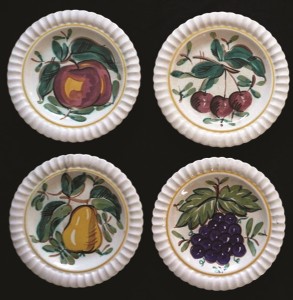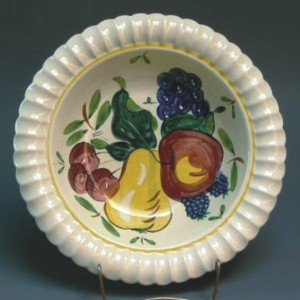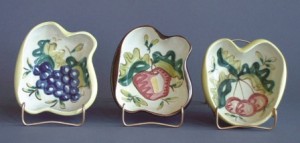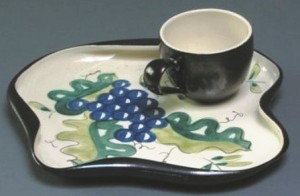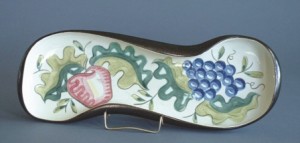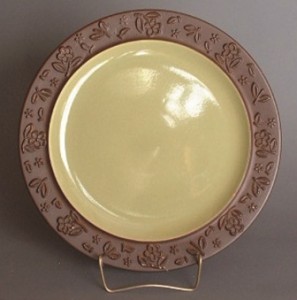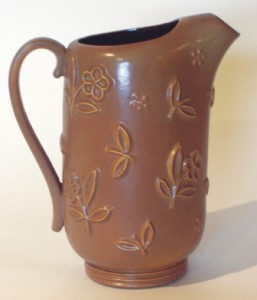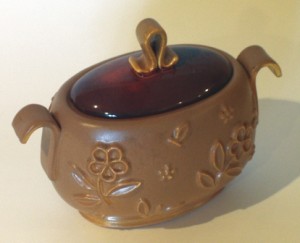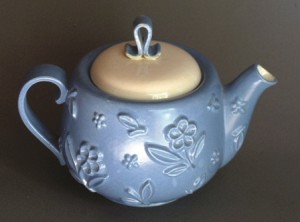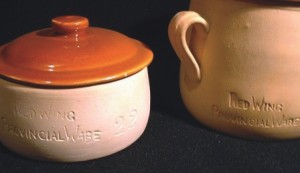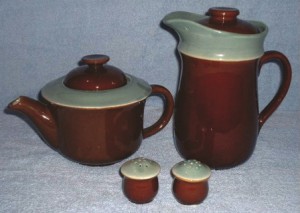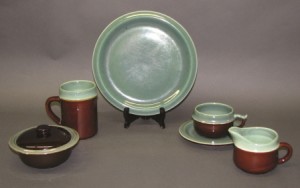The information presented here has been taken from the RWCS Newsletter Introduction to Dinnerware article series. Below is a brief summary of the early patterns by Red Wing.
Each pattern has been assigned an Availability rating and a Collector Interest rating as described below. Availability represents an average for the pattern in question, however the scarcity of certain pieces within the pattern may differ. Collector Interest refers to the pattern in general, but there may be specific pieces in any pattern that are of greater interest to specialty collectors (teapots, pitchers, salt & peppers, etc). Please keep in mind these ratings are the authors’ observations; your experience may vary.
| AVAILABILITY | COLLECTOR INTEREST |
| 1 Rare | 1 Highly sought, demand exceeds supply |
| 2 Very scarce | 2 Primarily of interest to specialty collectors |
| 3 Hard to find | 3 Above average |
| 4 Average | 4 Average |
| 5 Readily available | 5 Below average |
The Full Article includes where the information was found, availability and collector interest for the patterns.
Fruit or Salad Set Availability: 3 Interest: 4 Years: 1941 – 1946 ??
The “Fruit or Salad Set” was likely introduced in 1941. Exact production years are uncertain, but this set was included in Red Wing catalogs between 1942 and 1946. The set consisted of a 12.75” serving bowl and four 8.5” plates. Each plate featured one of four fruits: apple, pear, cherries or grapes. The artwork on the bowl includes all four fruits. All pieces had a fluted edge that resembled a pie crust rim. The Fruit or Salad Set was not a part of any dinnerware pattern, but elements of the artwork resembled designs used for Harvest and Party Ware.
Party Ware Availability: 3 Interest: 3 Years: Late 1940s – 1951 ??
Described in Red Wing promotional literature as “an unusual, colorful and decorative group that will serve all occasions for informal entertaining”. It was not a complete dinnerware set; it consisted of serving trays, plates, bowls and cups in amoeba-like shapes with curled edges. Party Ware was available in three exterior colors borrowed from the Concord line: Chartreuse, Gray and Metallic Brown. The hand painted apple, pear, cherries and grapes that decorated the interiors were borrowed from Harvest and the Fruit or Salad Set. Production dates are uncertain but this set was likely made in the late 1940s. A Party Ware sales brochure was dated January 1949.
Labriego Ware Availability: 1 Interest: 2 Years: Early 1940s
True Labriego dinnerware is very rare and was most likely never put into production. An undated “Labriego Ware” brochure showed a 13” oval plate, 15” round chop plate, coffee server, teapot, sugar & creamer, two casseroles, oval marmite, bean pot and salt & pepper shakers in four different finishes: Dark Brown/Chartreuse, Dark Brown/Orange, Gray/Maroon, and Gray/Turquoise. The exteriors featured raised-relief flowers and covers had a loop handle. This undated brochure was probably printed during the war years in the early 1940s. Only a very few pieces in these color schemes have been found. These pieces were likely models made for the brochure and possibly for display at trade shows. Perhaps concerns about the war put production plans for Labriego on hold.
Hospitality Ware Availability: 2 Interest: 3 Years: Mid to late 1940s
Many collectors refer to this pattern as “Labriego” but it was actually named Hospitality Ware. A 1948 Hospitality Ware brochure showed pieces in Labriego shapes but with different color schemes than shown on the previously mentioned undated Labriego brochure. The colors were now Blue/White, Yellow/White, Green/Dark Brown and Beige/Dark Brown. Most of the items from the earlier undated brochure were carried over, but the plate and chop plate were eliminated and a mug, water pitcher and round marmite added. Hospitality Ware pieces were not marked and they are often not recognized by the public as a Red Wing product.
Red Wing Provincial Cooking Ware Availability: 4 Interest: 5 Years: Early 1940s
This set consisted of only cooking and baking dishes: bean pot, stock pot, fry pan, marmite, two casseroles, egg dish and oval baking dish. Exact production dates are unknown but this set was made during the World War II years. The exteriors were bisque (unglazed) and tan in color while the interiors and covers had a rust-colored glaze. Each piece had “Red Wing Provincial Ware” stamped into the clay on the side along with a stock number. This line sold well but the bisque exteriors were very difficult to keep clean as spills and drips baked into the unglazed clay. Today it is tough to find pieces that aren’t stained. In the 1960s Red Wing reintroduced this line as “Provincial Bakeware”. Exteriors on the 1960s version had a tan glaze that makes cleaning easier, and they were marked on the bottom rather than on the side.
Bakeware (Oomph) Availability: 4 Interest: 4 Years: 1943 – mid-1940s
Better known as “Oomph”, Bakeware was another utilitarian line that was introduced during the war years. The proper name for this pattern is Bakeware. But a promotional brochure prominently displayed the slogan “Red Wing Puts the ‘OOMPH’ into Earthenware”, and Oomph came to be the more commonly used name. Oomph had a heavy, substantial feel compared to most other dinnerware lines. The green and dark brown color combination causes Oomph to frequently be confused with Red Wing’s later Village Green pattern, as well as with similar wares from other potteries. One way to differentiate Oomph from Village Green is the band of green found on the rim of many Oomph pieces but not on Village Green. Like Provincial Cooking Ware, Oomph included numerous casseroles and baking dishes. But Oomph also included plates, cup & saucer, mug, pitcher, teapot, salt and pepper shakers, etc. which made Oomph a dinnerware pattern rather than a mere cooking set.


